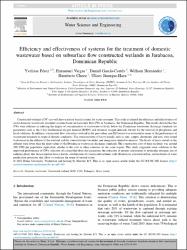| License | This is an open access article under the CC BY-NC-ND license. | es |
| Author | Pérez, Yvelisse | |
| Author | Vargas, Enmanuel | |
| Author | García-Cortés, Daniel | |
| Author | Hernández, William | |
| Author | Checo H., Humberto | |
| Author | Jáuregui-Haza, Ulises | |
| Accessioned date | 2023-10-10T23:39:17Z | |
| Available date | 2023-10-10T23:39:17Z | |
| Year | 2023 | |
| Citation | Pérez, Y., Vargas, E., García-Cortés, D., Hernández, W., Checo, H., & Jáuregui-Haza, U. (2023). Efficiency and effectiveness of systems for the treatment of domestic wastewater based on subsurface flow constructed wetlands in Jarabacoa, Dominican Republic. Water Science and Engineering [article in press]. Recuperado de:. | es |
| URI | https://bvearmb.do/handle/123456789/3440 | |
| Abstract | Constructed wetlands (CW) are well known nature-based systems for water treatment. This study evaluated the efficiency and effectiveness of seven domestic wastewater treatment systems based on horizontal flow CWs in Jarabacoa, the Dominican Republic. The results showed that the CWs were efficient in reducing the degree of contamination of wastewater to levels below the Dominican wastewater discharge standards for parameters such as the 5-day biochemical oxygen demand (BOD5) and chemical oxygen demand, but not for the removal of phosphorus and fecal coliforms. In addition, a horizontal flow subsurface wetland in the peri-urban area El Dorado was evaluated in terms of the performance of wastewater treatment in tropical climatic conditions. The concentrations of heavy metals, such as zinc, copper, chromium, and iron, were found to decrease in the effluent of the wetland, and the concentrations for nickel and manganese tended to increase. The levels of heavy metals in the effluent were lower than the limit values of the Dominican wastewater discharge standards. The construction cost of these facilities was around 200 USD per population equivalent, similar to the cost in other countries in the same region. This study suggested some solutions to the improved performance of CWs: selection of a microbial flora that guarantees the reduction of nitrates and nitrites to molecular nitrogen, use of endemic plants that bioaccumulate heavy metals, combination of constructed wetlands with filtration on activated carbon, and inclusion of water purification processes that allow to evaluate the reuse of treated water. | es |
| Language | English | es |
| Published | Water Science and Engineering [article in press] | es |
| Rights | © 2023 Hohai University. Production and hosting by Elsevier B.V. | es |
| Rights URI | http://creativecommons.org/licenses/by-nc-nd/4.0/ | es |
| Subject | Recursos naturales - República Dominicana | es |
| Subject | Recursos hídricos | es |
| Subject | Contaminación ambiental | es |
| Subject | Tecnología | es |
| Title | Efficiency and effectiveness of systems for the treatment of domestic wastewater based on subsurface flow constructed wetlands in Jarabacoa, Dominican Republic | es |
| dc.identifier.doi | https://doi.org/10.1016/j.wse.2023.08.004 | |
| Material type | Article | es |
| Type of content | Scientific research | es |
| Access | Open | es |
| Audience | Technicians, professionals and scientists | es |


